We love our rain gauge, especially when it actually gets to do its job.

Welcome, rain! Please visit more often.
We love our rain gauge, especially when it actually gets to do its job.

Welcome, rain! Please visit more often.
We’re up to somewhere between a dozen and 15 hummingbirds at the feeders now. I’m not sure whether our resident hummers are still here, but the rest are certainly in migration from up north and are gathering energy for their trip farther south and soon thereafter across the Gulf of Mexico. The birds are starting to share the feeders more and more, mostly because there are so many hummers now that individuals don’t really have a chance to defend their territory.
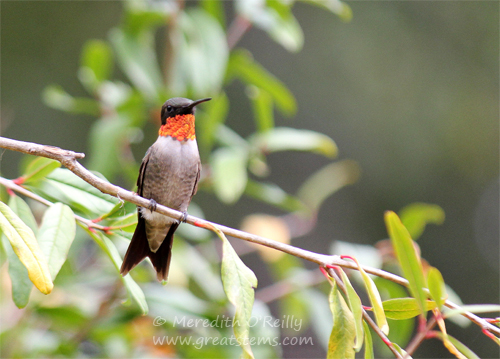
I know I have taken (and shared) lots of hummingbird pictures in the past, but it’s hard not to — the birds beckon me with their spirited antics, and I enjoy sitting out there absorbing their happy, frenzied presence. But if I find myself outside without my camera, I long for it, so mostly I just bring it along and try to get a great shot. Then, of course, I feel obligated to share.

Most of the time I use my zoom lens with hummingbirds, because it enables me to get shots like this lucky tongue image.
I also can capture pollen on a hummingbird’s bill. If you ever wondered whether a hummingbird is an effective pollinator, there’s proof.
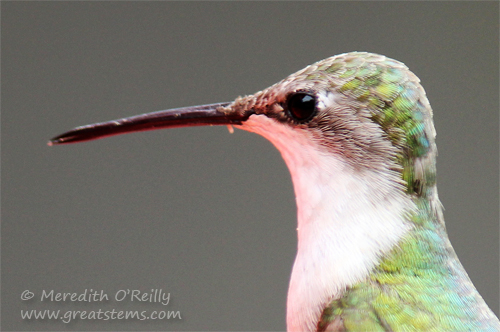
With the zoom, I can also get close enough to get feather details on the little birds and yet not disturb them.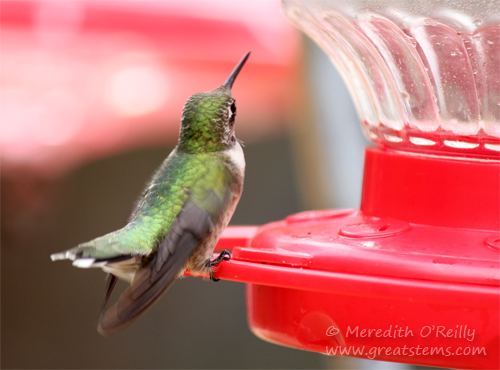

The downside to the zoom is that it gets tougher to capture the interaction between birds (when they really get their speed going). But it’s doable.
Today, however, brought a most enjoyable experience, all thanks to an annoying tilt of the shepherd’s hook holding two of our feeders. I couldn’t resist trying to fix it during a momentary lull in hummingbird activity. I had scarcely put my hand on the shepherd’s hook when suddenly I was surrounded by fast-moving, buzzing hummingbirds. There I was, inches from two feeders, and birds were swarming me. At first they circled me, periodically hovering in front of my face to see whether I was friend or foe, and since I didn’t move a muscle (other than to softly talk to them), they decided I was friend, or at least safe enough. Just inches from my face, they sat, drank, hovered, checked me out, drank some more, and even had their usual feisty spats. The breeze from their wings felt great upon my skin, and it was impressive how much air movement there was.
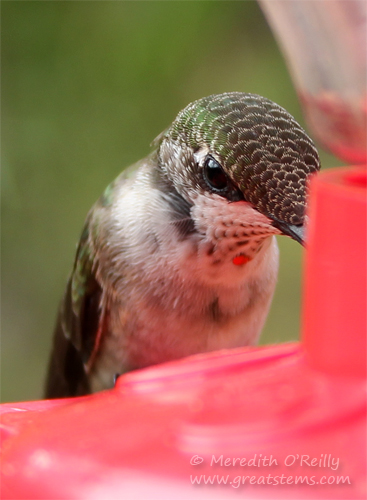
During another lull of activity, I quickly went inside to grab a regular lens, hoping to get a picture (the zoom wouldn’t have worked that close to my subjects). But I soon learned that while the hummingbirds did not mind me, they were less fond of my camera. Perhaps the lens looked like a large gaping mouth. Whichever feeder my face was near, the birds sat and drank without concern. Whichever feeder my camera faced, the birds were hesitant to linger at the feeder, and only a couple did fly-by drinking. Needless to say, it was a challenge to actually take a picture with a hummingbird in it, but I managed a couple. The above is my favorite.
Of course, once I realized how unperturbed the hummingbirds were by my presence, I encouraged my family to experience the thrill of being so close to the zooming birds. I can report that the hummingbirds did not mind Nolan’s small point-and-shoot camera. I think the “big lens = big mouth” theory might be close to the truth.
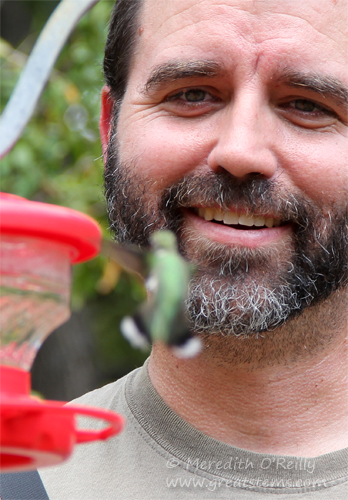
If you have visiting hummingbirds, especially in large numbers, I highly recommend you give it a try. Perhaps you’ll get to experience those lovely hummingbird breezes on your skin, too.
While helping with the fall 2013 Habitat Stewards class today at Hornsby Bend, I stopped to admire the construction and predatory skills of a few beautiful spiders who had picked prime flying-insect-rich real estate in which to build their giant webs.
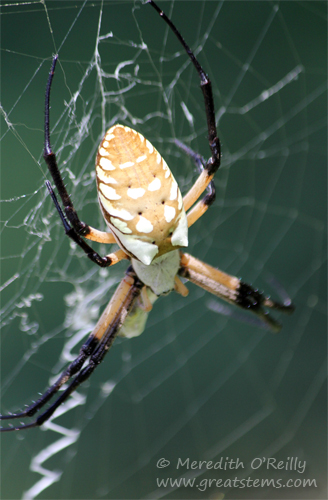
Argiope aurantia, known as the common garden spider, is generally a large yellow and black spider, though of course it can have color variations as you see above. Its big web can easily be two feet across, not including the framework. While Argiopes are generally considered solitary spiders, the insect activity in the area was enough to keep several of the spiders in close proximity. Danger, insects, danger!
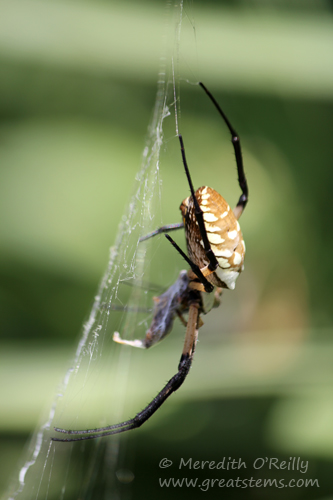
 The garden spiders are sometimes called Writing Spiders because of the zig-zagged stabilimenta they create in the center of their webs.
The garden spiders are sometimes called Writing Spiders because of the zig-zagged stabilimenta they create in the center of their webs.
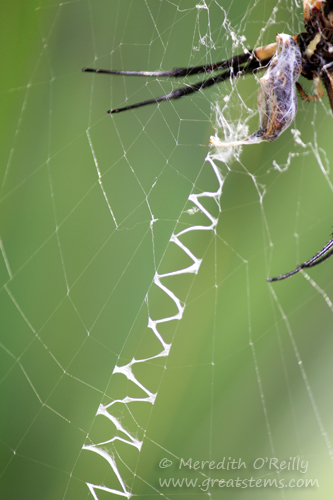 Here’s a better view of the stabilimentum of one of the Argiope aurantia. There are many theories about why some diurnal orbweaver spiders create such features in their webs, but it would seem that the stability theory for which the stabilimentum got its name has been disputed. It’s possible, though, that it has something to do with visibility, mating, predator avoidance, or attracting prey.
Here’s a better view of the stabilimentum of one of the Argiope aurantia. There are many theories about why some diurnal orbweaver spiders create such features in their webs, but it would seem that the stability theory for which the stabilimentum got its name has been disputed. It’s possible, though, that it has something to do with visibility, mating, predator avoidance, or attracting prey. 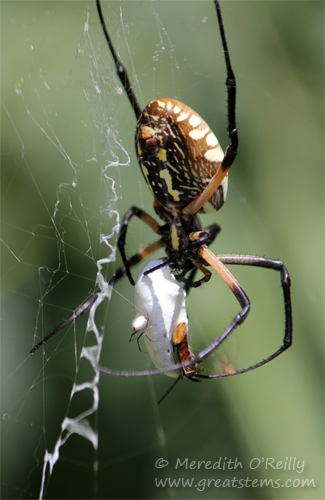
But the real story today isn’t about the gorgeous garden spiders, which normally would have me oohing and aahing. Okay, I’m still oohing and aahing, but what I really mean to talk about is the fact that a big orbweaver such as Argiope aurantia isn’t always the only spider in its web. In the above photo, a tiny dewdrop spider (Argyrodes elevatus) is sharing the meal of the larger spider.
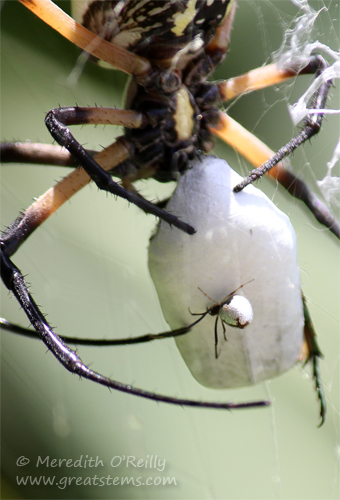
If you know how big garden spiders can get, then you should have an idea about just how much smaller the little dewdrop spider is. Yet there it is, bravely coming in to get some of food caught by the bigger spider. Dewdrop spiders, by the way, are members of the cobweb-weaver family. Presumably they are capable of building their own web, but why bother if they can steal from another predator instead? Clever little spiderses.
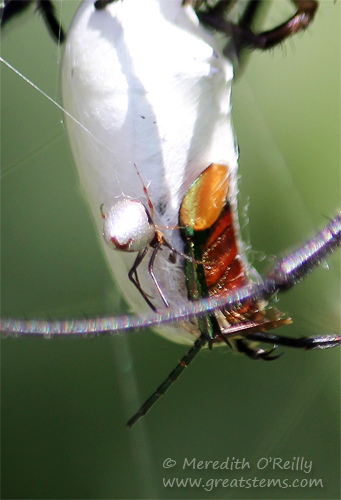
This behavior of stealing food is called kleptoparasitism. Cuckoo bees, seagulls, hyenas, and vultures — and our dogs — are some of the other animal species known to be kleptoparasitic, at least occasionally. In the case of our arachnid friends, sometimes a thieving spider will make a meal of tiny insects that get caught in the big web, and in doing so it helps keep the web clear without really affecting the Argiope spider. But when a nice big juicy bug gets caught and subsequently nabbed by the large garden spider, the little dewdrop spider will carefully approach the wrapped and pre-digested larger prey and secretly consume some of it, while making sure to avoid the attention of the big predator close by, lest it become a meal itself. Actually, some kleptoparasitic spiders have also been known to eat the host spider, but presumably the big spider has to die first.
Speaking of which, I watched a huge metallic beetle fly into another big web and got ready to take pictures of the sudden ambush from the orbweaver. But the orbweaver didn’t move, despite violent and desperate attempts of the beetle to escape the sticky web. I took a small twig and gently nudged the spider, and it didn’t move. I wonder why it died in the center of its web — very odd. No klepto spiders were eating it yet; perhaps they will, though, or maybe a bird will swoop it up if it can do so safely. Meanwhile, I used the twig to release the beetle, and it flew away to live another day… or at least a few more minutes until it zips into another silky deathtrap.
September is one of my favorite months, for the hummingbirds are moving through Texas in large numbers at this time, and it means my garden is busy with little bird antics left and right (and up and down).
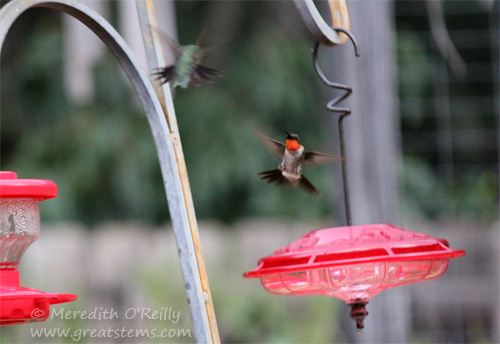 The sounds of the feisty little birds draw me outside. The hummingbirds are usually so focused on defense and territoriality and getting nectar that they hardly noticed the humans taking pictures, dogs running amok, and thunder or other noises in the background. Such was this evening’s setting.
The sounds of the feisty little birds draw me outside. The hummingbirds are usually so focused on defense and territoriality and getting nectar that they hardly noticed the humans taking pictures, dogs running amok, and thunder or other noises in the background. Such was this evening’s setting.
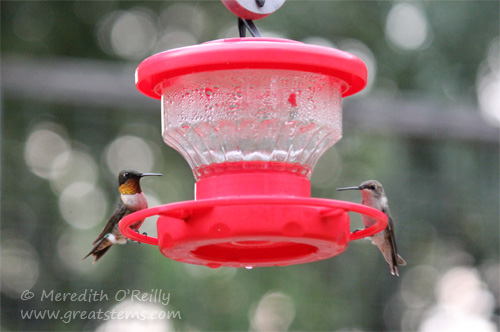 Occasionally hummingbirds will settle down and share a feeder. In fact, as more hummers appear during migration, they will share more and more, as the need to build up energy stores for long-distance travel becomes more pressing.
Occasionally hummingbirds will settle down and share a feeder. In fact, as more hummers appear during migration, they will share more and more, as the need to build up energy stores for long-distance travel becomes more pressing.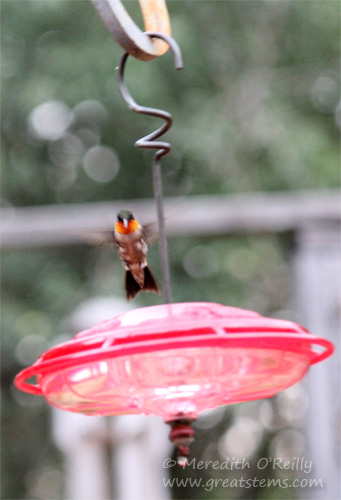 During migration season, the vast majority of the hummingbirds I see in my Austin garden are Ruby-throats. The males have the iridescent gorget, which seems truly vibrant when the light is just right (but otherwise it looks dark).
During migration season, the vast majority of the hummingbirds I see in my Austin garden are Ruby-throats. The males have the iridescent gorget, which seems truly vibrant when the light is just right (but otherwise it looks dark).
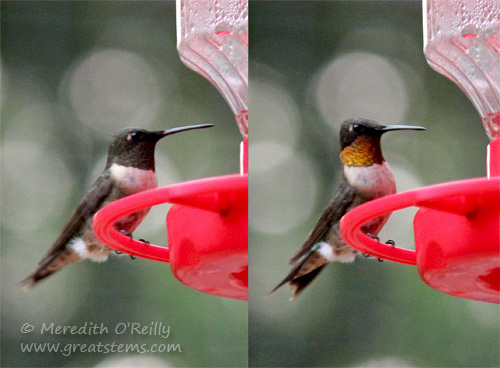
Because the male’s gorget often appears dark, Ruby-throats are often confused with Black-chinned hummers. But take a look at how this male’s feathers light up with just a slight change to its body position. The color you see is actually a function of feather structure and the refraction of light at particular angles and is not a result of pigmentation.
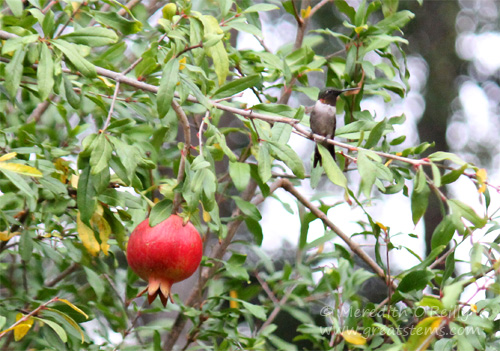
Don’t be fooled into thinking this hummingbird, almost hidden among the leaves, is remarkably big, given the pomegranate nearby as a size comparison. That’s actually a small pomegranate (the big pomegranates have weighed their respective branches down much closer to the ground, and no hummingbirds ever hang out down there).
Aside from the feeders, our backyard trees are territorial zones for many of the hummingbirds, who stake claim not just to particular trees but to very specific branches on said trees. The bird above was the only one using that spot on the Pomegranate — he drove away any other hummer that came too close. Likewise, the Mexican Redbuds were claimed by a few hummingbirds, likely because they were close to three feeders. The nearby Oak trees offered higher vantage points, so some hummingbirds used those instead.
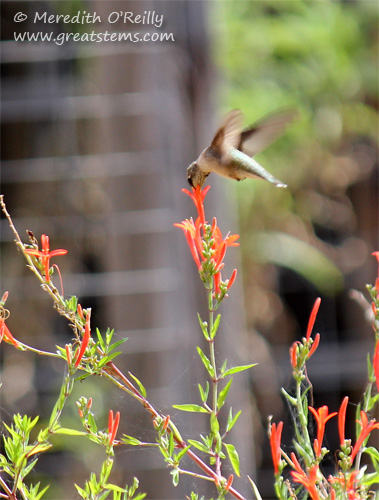
Of course, native plants offer the best nectar of all, but I always put out feeders during migration because it can be hit or miss whether any of my natives are blooming in the hot Texas summer. Often, I’m relying on my trusty Flame Acanthus to be in bloom while summer is still blazing. Indeed, my Flame Acanthus is blooming right now, but I’m cheating and showing a picture I took last year. And actually, fyi, I keep feeders up year round, though perhaps not as many in the winter. You never know when a slowpoke hummingbird will desperately be seeking food sources in the cold.
If you have feeders, be sure to use a ratio of 1 part Table Sugar to 4 parts water — don’t add coloring.
And always keep your feeders clean! Replace the sugar-water every 2-3 days to prevent fermentation, and use that opportunity to scrub out the feeders thoroughly. I use vinegar to clean mine (and small brushes). Don’t let any black yucky stuff build up in those nooks and crannies!
For those of you up north who are saying a seasonal goodbye to hummingbirds, thank you for taking good care of them. They’ll be back in the spring to say hello before you know it!